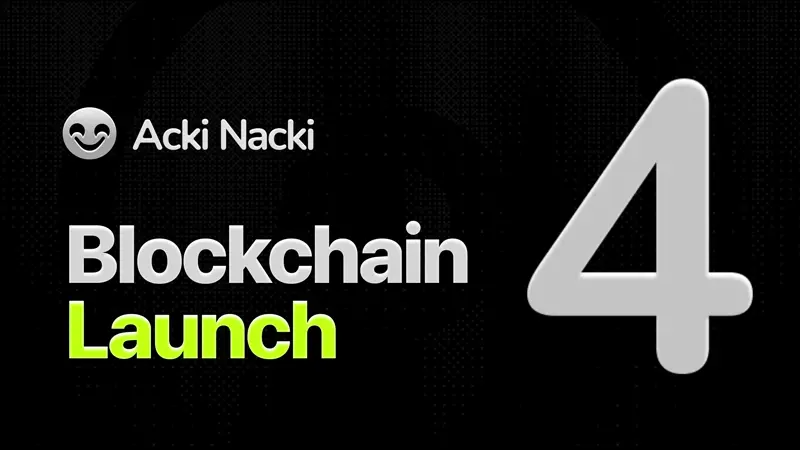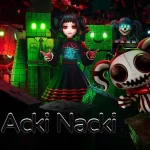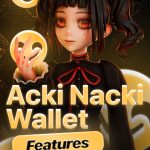Die Last is currently in development: the Testplay phase has finished, and further development will resume after the Acki‑Nacki mainnet launches. This MMORTS, built fully on-chain, has completed its stress-testing on testnet and is now poised to transition into live operation once Acki‑Nacki goes mainnet.
What is Die Last and why it matters
At its core, Die Last is a massively multiplayer online real‑time strategy game operating entirely on GOSH’s Acki Nacki blockchain, no “hybrid backend,” no private servers. Every move, unit, resource, guild action, and strategic decision happens on‑chain. That’s radical. It turns MMO‑style wargaming into public protocol.
This isn’t some collectible‑slackpile DApp but a world where players rebuild a post‑industrial wasteland together: planting trees, building pipes, forging alliances, forging betrayal. All via tokens and NFTs you craft in‑game that map directly to protocol assets. Sources confirm that Die Last is lovingly built, open source, player‑governed through a DAO on GOSH, and intentionally structured so that Karma earned in‑game becomes your voting leverage in the Die Last DAO, tied to the tradable governance token called LAST.

AirDrop status & token details
In May 2024, GOSH kicked off the first-ever in‑game token airdrop, where you earn LAST tokens by playing: digging Lost Objects, crafting a message using an “English Spy Radio” shard, and sending it to Da Vinci’s Parachute Factory in‑game. That action mints an NFT via the game; later you claim the NFT on dielast.io, which becomes your entry solution for contributing to or buying tokens.
Each NFT carries a discount parameter, some players lucked into 100 % free tokens; others could earn at 1 % discount. For every free token minted, one more is minted to be sold via DAO treasury. In total there will be no fewer than 100 million LAST tokens. Unclaimed tokens flow back to DAO and can be sold later at the DAO’s discretion.
It’s a clever mechanism: the airdrop functions like call options, players earn, scout, buy, gamble, without any pre‑mined supply or team allocation, keeping distribution purely community‑centric.
Game mechanics & on‑chain integration
Die Last layers:
-
Open source & decentralized development: All code stored on‑chain in the Die Last DAO. Anyone can contribute, fork, or propose changes.
-
In‑game NFT crafting: Shard‑collecting and message sending translates straight into NFTs minted on the Acki Nacki chain via the gameplay client. It’s seamless, your in‑game act is a transaction.
-
Karma vs LAST: Karma is your in‑game currency; LAST is the tradable token tied to DAO voting. Karma usage is gated by how many LAST tokens you own.
-
Regenerative loop: Players collectively restore a dying world, confronting decay with strategy, resource allocation, betrayal, alliance. Every city reborn, every pipeline rebuilt, happens through player coordination—and all is recorded on‑chain.
As far as we know, Die Last is the first protocol where gameplay equals validation equals governance. Think Popit Games but scaled into persistent MMORTS form.

Development timeline & current phase
The game has successfully undergone test‑net playtests, with players able to register via Steam (if approved) and enter the world, limited capacity at first, then gradually wider access. The current phase is testnet, fully working, and waiting for Acki Nacki’s main net launch to unlock full development and player scalability.
A second blog from June 2024 confirms that community registrations, crafting steps, and DAO governance structure were all functional in testnet. Comments show real curiosity and hype from early adopters.
Why it’s unique (and why I’m intrigued)
-
First‑in‑kind on‑chain real‑time MMO RTS: There are MMORTS games, but none have this level of real‑time strategy fully mapped to blockchain ops.
-
DAO governance baked in: Every participant can vote on game evolution via LAST token holdings. Karma is gaming identity; LAST is governance power.
-
Tokenomics as play incentive: Rewards aren’t bribes, they’re gameplay output. You earn by participating, not by playing influencer marketing.
-
Open‑source & remixable: Imagine a game so modular that players, or other studios, can fork it, propose new features, and even launch tournaments.
-
Community‑distributed launch: No pre‑mined allocations, no hidden VC fuels. It’s grassroots. That’s rare.
Risks & caveats
Of course, with innovation come questions:
-
Security: Game logic writes blocks. Bugs could be catastrophic. I haven’t seen full audits published yet.
-
Fairness & bots: Could advanced players or automations corner the airdrop or early LAST sale? The DAO model may rebalance, but early edge matters.
-
Token value & liquidity risk: If someone dumps tokens or demand fizzles, rewards collapse. There’s no strong marketplace yet; DAO will choose launch platforms later.
-
Regulatory gray: If gameplay = mining = earning LAST with monetary value, how will regulators treat the model? No financial counsel yet.
-
Steam‑limited access: Early playtest slots are gated. Some players complaining about email approval delays. Potential bottleneck.
Player guidance & participation path
If you’re curious and want to dive in:
-
Wishlist Die Last on Steam and register in the Die Last DAO via the GOSH blog link. That opens the door to playtest access.
-
Explore the game, dig Lost Objects until you find English Spy Radio shards, craft your message, send it to Parachute Factory to mint your NFT.
-
Claim that NFT at dielast.io with your seed phrase. That NFT is your claim right for LAST tokens.
-
Trade or hold, some NFTs confer free LAST; some require up to 100% purchase. You can sell your NFT or convert later.
-
Join the DAO, stake your LAST or cast votes with Karma power. That’s where real influence lies.
Ecosystem context: Acki Nacki & GOSH
Die Last is just one case in GOSH’s broader L1 ecosystem. Acki Nacki claims asynchronous consensus with finality in two message rounds, sub‑second speed, minimal latency, optimized for gaming, AI, IoT. No pre‑mined tokens; sold via node sale to community.
Die Last and Popit Games form the first frontlines, content-first, then tokenomics-first. In late June 2025 Popit Games launched with a $1 million tournament, $NACKL mining via gameplay, cross‑game node reward layers, all stressing the same protocol. Die Last is the strategic extension of that vision.
What’s next?
-
Mainnet goes live: This unlocks full game scaling, open onboarding, competitive leagues, guild wars, alliances, sabotage networks.
-
FULL token launch & liquidity: DAO will likely list LAST on launchpads or DEXs; DAO treasury sells unclaimed tokens to fund growth.
-
Tournaments and esports: Die Last is structurally suited for guild leagues, strategic tournaments, long‑form campaigns, potentially backed by pop‑up prize pools.
-
Mechanic expansion via DAO votes: Community may propose upgrades, map rotation, cluster worlds, asynchronous campaigns, mod forks.
-
Ecosystem cross‑pollination: Maybe Popit card mechanics in Die Last, maybe merging token types, maybe cross‑game staking.
Verdict: Why I’d put THIS on my radar
If you follow the faint trail of crypto gaming, this is one of the rare models treating gameplay as protocol, value as governance, art as open source. It’s more than a play‑to‑earn; it’s a live-world experiment in co‑governed strategy.
The infrastructure (Acki Nacki), the philosophy (no pre‑mines, community distribution), the mechanics (real game logic mapping directly to chain states), all cohere into something unprecedented.
If it scales, bugs get fixed, DAO stays responsive, and regulators don’t freak out, Die Last could seed a new category: MMORTS-as-protocol. That’s not hype, it’s a future.
🎮 TL;DR Table
| Feature | Status / Detail |
|---|---|
| Game | Fully on-chain MMORTS by GOSH on Acki Nacki |
| Phase | Testnet playtest live; awaiting main net launch |
| Token | LAST (tradable, governance); earned via in-game airdrop |
| Airdrop | In-game NFT craft using Spy Radio shards → claim NFT → convert to LAST |
| Code | Open source; managed by player DAO |
| Governance | Karma = in-game credit; LAST = voting power |
| Risks | Security, fairness, token value, access gating, regulation |
| Upside | Unprecedented on-chain synergy; community-run; strategic depth |
🧾 Final note (in my voice)
Once you sign in, start digging shards, craft your first NFT message. You may feel like you’re scavenging in a ruined world, but what you’re doing is shaping a chain-born multiplayer civilization. Every spy radio, every pipeline, every tree planted is a blockchain transaction, immutable footprint of strategy.
This is not just a game you play. It’s a protocol you live. And if it works, Die Last could be the first of many games where your strategy equals your stake, and your gaming equals governance. A hundred million LAST tokens is enough to build communities, guilds and wars that last generations.
The ending is not certain, but I’m optimistic. Because when players govern the world they rebuild, and gameplay writes the future, they don’t just play, they persist. The wasteland can bloom. And maybe, just maybe, Die Last is the seed.
To anyone reading: DYOR. Check the official GOSH blog posts (“Die Last AirDrop is Live” and “Step‑by‑Step Guide”) and visit dielast.io. Then decide: will you sign the message? Will you build? Or will you wait and watch?
Because soon, the chain will wake, and Die Last might be the place where gaming finally becomes permanent.
Sources used:





